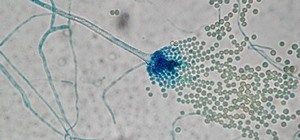Jostled in the airport, someone is coughing in line. The air looks empty but it is loaded with microbes that make their way into your body. You get sick. You give it to your family, and that's pretty much it. But what if you were so contagious that you spread it to your entire community and beyond?
Infectious disease is spread every day in multiple ways. A new study in the Proceedings of the National Academy of Sciences looked at the 2014 outbreak of Ebola and found infectious disease is taking an increasingly dangerous route—through superspreaders.
One of the most notorious superspreaders in history was Typhoid Mary. Born in Ireland, Mary Mallon emigrated to the US in 1884 when she was 15 years old. She found work as a cook and domestic servant, but unknown to her and her employers, Mallon was an asymptomatic carrier of Salmonella typhi.
Though she had no symptoms, Mallon eventually infected 51 people with typhoid fever, three of which died. An epidemiologist with the New York City Health Department was able, with significant effort, to track Mallon and investigate the infection she spread. Mallon was eventually quarantined on an island permanently after refusing to give up work as a cook. She died alone, without friends or family, on the island at the age of 69.
Superspreader is a term used to informally describe people who spread infection in a disproportionate way. These highly infectious individuals are not easy to identify given the variability of how each infection presents. The 2003 outbreak of severe acute respiratory syndrome (SARS) is largely owed to superspreaders.
In that outbreak, one hospitalized index patient was associated with 125 secondary cases. Another index patient led to more than 180 cases, and one air traveler caused 22 secondary cases as the infection flew between Hong Kong and Beijing. Eventually, the infection spread to Vietnam, Singapore, and Canada.
In an outbreak, an index case is the individual at the root of a transmission tree. Analyzing how an index case spreads contagion is as essential as planning medical care for newly infected victims. At both ends of the equation—at infection and with treatment—healthcare workers have an opportunity to slow the spread of an infectious disease and possibly avoid an outbreak.
20% of People Spread 80% of an Infectious Disease
An informal rule dictates that 20% of people spread about of 80% of all infectious disease. This Ebola study analyzed transmission trees and looked at community-based datasets involving location, age, gender, symptoms, and time of burial. Their findings underscore the imperative of identifying superspreaders as quickly as possible to avoid an outbreak or epidemic.
"In the recent Ebola outbreak it's now clear that superspreaders were an important component in driving the epidemic," said co-author Benjamin Dalziel, an assistant professor of population biology in the College of Science at Oregon State University, in a press release.
Other participants in the study include Princeton University (who led the research), Imperial College London, the London School of Hygiene and Tropical Medicine, the IFRC, and the National Institutes of Health.

Points of the study about the Ebola virus outbreak and superspreaders include:
- If individuals who were superspreaders had been identified and handled more quickly, approximately 61% of the Ebola outbreak cases would not have occurred.
- The Ebola outbreak was a community-based epidemic, as opposed to SARS which centered on hospital settings.
- In this epidemic, patients who were young or elderly were more likely to be superspreaders. Study authors suggest these two groups could have had more social contacts and caregivers, and remain infectious longer than otherwise healthy adults.
At the outset of an outbreak, hospital beds fill quickly and local health officials become overwhelmed trying to identify and contain new cases. An important strategy to avoid a longer cycle of contagion and reduce casualties is identification of index cases and their contacts. Researchers note:
[D]uring the 2014–2015 EBOV epidemic, millions of dollars were spent implementing message strategies about Ebola prevention and control across entire countries; our results suggest that message strategies targeting individuals with higher risk may be useful to prevent superspreading events and the persistence of the outbreak.
Context is critical when identifying superspreaders. Why are some people superspreaders while other are not? Secondary cases cluster around index patients for many reasons, including:
- Superspreaders may be co-infected with another pathogen that makes them exceptionally contagious. For example, an individual suffering a sexually-transmitted disease and HIV is more likely to spread HIV. Pathogens can boost the successful spread of fellow pathogens.
- The body of a highly infectious person may shed stronger or more abundant pathogens. Individuals with an already compromised immune system could also harbor pathogens with few or no symptoms.
- Environmental, not physical, factors can create conditions favorable for an index patient to spread disease. Poor quarantine protocols, crowded spaces, hospital transfers, contaminated surfaces, and malfunctioning plumbing are just some of the mechanical reasons contagion of a virulent pathogen could be spread. These variables do not necessarily mean the index case was physically more contagious.
- Pathogens may intrinsically coalesce in certain people for as yet unknown reasons.
Animals and birds can become superspreaders within their species and by passing zoonotic pathogens to humans. While the deadly Middle East respiratory syndrome coronavirus (MERS-CoV) is spread between humans, camels are a main reservoir of the disease which they can spread directly to humans.
As health agencies continue to develop techniques to identify and track index cases and superspreaders, one study created a Susceptible-Exposed-Infected model to simulate contagion spread in a large urban setting.

The model suggests that those who travel widely, with the most contacts, are more likely to spread significant contagion in the event of an outbreak. Given the fine-grained nature of personal data publicly available, such as through transit passes, or even Google search, it is not inconceivable that media and metrics could help pinpoint likely areas, or individuals, ripe for outbreak.
"As we can learn more about these infection pathways, we should be better able to focus on the types of individual behavior and demographics that are at highest risk for becoming infected, and transmitting infection," Dalziel said.
A basic variable in defining an epidemic is the number of new cases generated by a patient. If that patient is a superspreader, an epidemic may be only a matter of time.
Just updated your iPhone? You'll find new emoji, enhanced security, podcast transcripts, Apple Cash virtual numbers, and other useful features. There are even new additions hidden within Safari. Find out what's new and changed on your iPhone with the iOS 17.4 update.



























Be the First to Comment
Share Your Thoughts